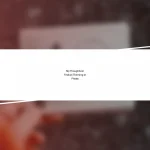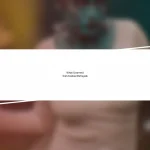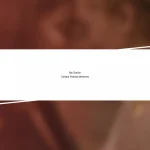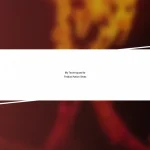Key takeaways:
- Art serves as a powerful medium for exploring and expressing cultural identities and shared human experiences.
- Personal experiences significantly influence the creation and appreciation of art, allowing for deep emotional connections to cultural narratives.
- Choosing the right medium and integrating traditional with modern styles enhances the storytelling aspect of art, bridging generational and cultural gaps.
- Community engagement through art fosters connection and understanding, transforming spaces into vital hubs for cultural exchange and shared memories.

Understanding culture through art
Art serves as a vibrant lens through which we can examine and understand various cultures. I remember attending an art exhibition focused on Indigenous art; each piece told a story of heritage, struggle, and resilience. It made me question: how often do we overlook the voices and histories embedded in the art around us?
When I create or appreciate art, I often find that it reflects the nuances of my cultural experiences. For instance, during a pottery workshop celebrating traditional techniques, I felt connected to generations before me. That tactile engagement reminded me that culture is not just a set of beliefs; it’s the very essence of our creation, shaped by time, place, and emotion.
Consider this: how does a piece of art make you feel in relation to your own cultural identity? I’ve found that art can bridge gaps between cultures, allowing us to recognize our shared human experience. It’s fascinating how a simple painting or a song can evoke deep emotions, stimulating reflection on who we are and where we come from.
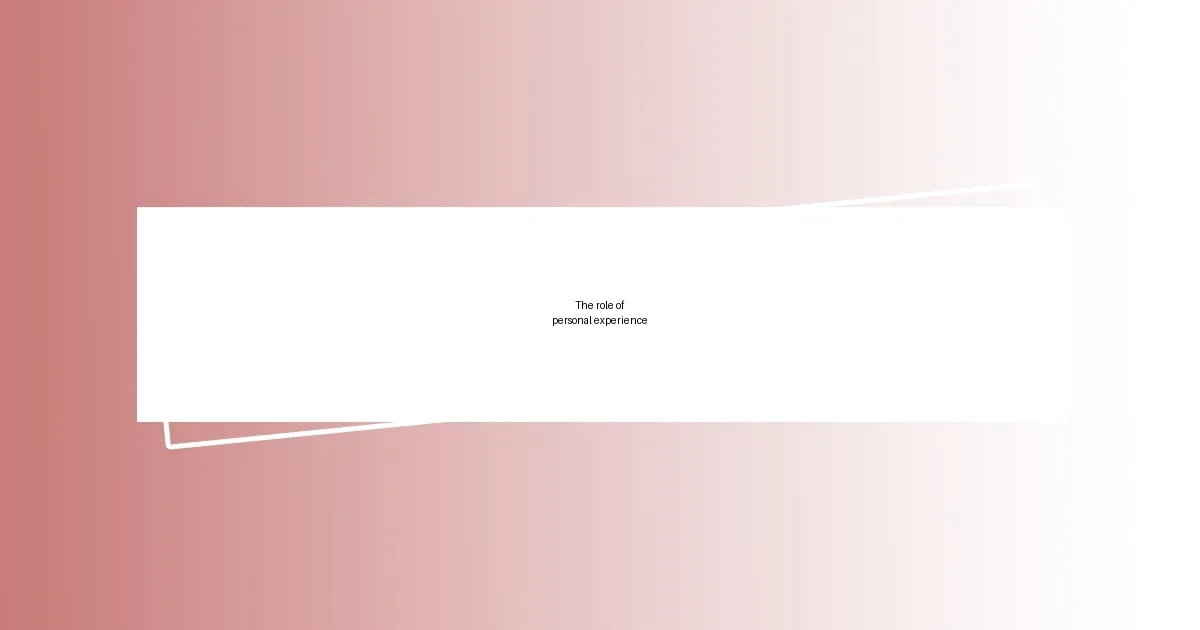
The role of personal experience
Personal experiences play a crucial role in how I connect with culture through art. I recall a time when I participated in a mural project in my community. Each stroke of the brush felt like a release, channeling the vibrant stories of my neighborhood into vivid colors. It was more than just painting; it was a collective expression of our shared histories, aspirations, and dreams woven together on the wall.
- Art nurtures an emotional connection, evoking memories and experiences that define us.
- My childhood visits to cultural festivals inspired my own artistic expressions as I learned to appreciate the richness of diverse traditions.
- Each artwork I create becomes a narrative, shaped by my unique lens, linking personal experiences with broader cultural contexts.
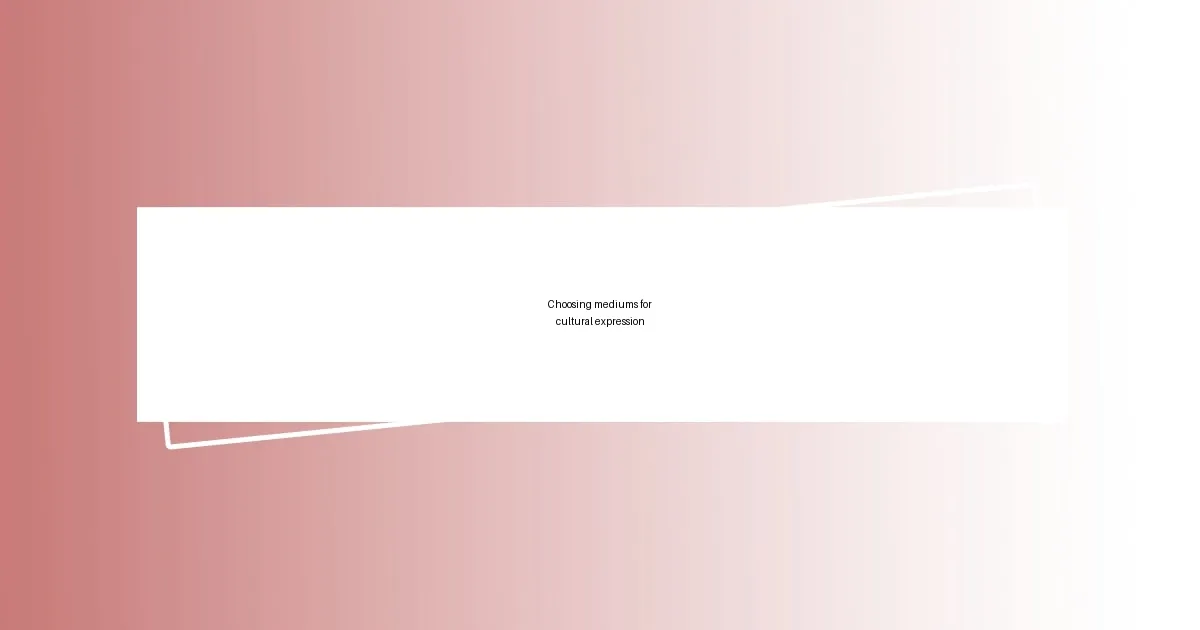
Choosing mediums for cultural expression
Choosing the right medium for cultural expression can be a deeply personal decision. I often experiment with mediums like painting, sculpture, and photography, finding that each has its own unique way of telling a story. For example, the tactile nature of sculpting clay allows me to express my heritage’s physicality, while photography captures fleeting moments that echo my cultural identity.
Then there are the moments when I consider the impact of digital media. Social platforms have opened new doors for cultural expression, allowing diverse voices to be heard. I remember posting a digital collage that blended traditional patterns with modern themes. The feedback was invigorating and showed me how art can transcend geographical boundaries, connecting varied cultural narratives in surprising ways.
In choosing a medium, I reflect on how it aligns with my message. A vibrant oil painting might express joy and celebration, while a minimalist line drawing could convey introspection and simplicity. The choices I make in my artistic journey always circle back to how well they resonate with my cultural story.
| Medium | Emotional Impact |
|---|---|
| Painting | Evokes joy and celebration |
| Sculpture | Conveys physical connection to heritage |
| Photography | Captures moments and memories |
| Digital Art | Transcends boundaries and connects narratives |
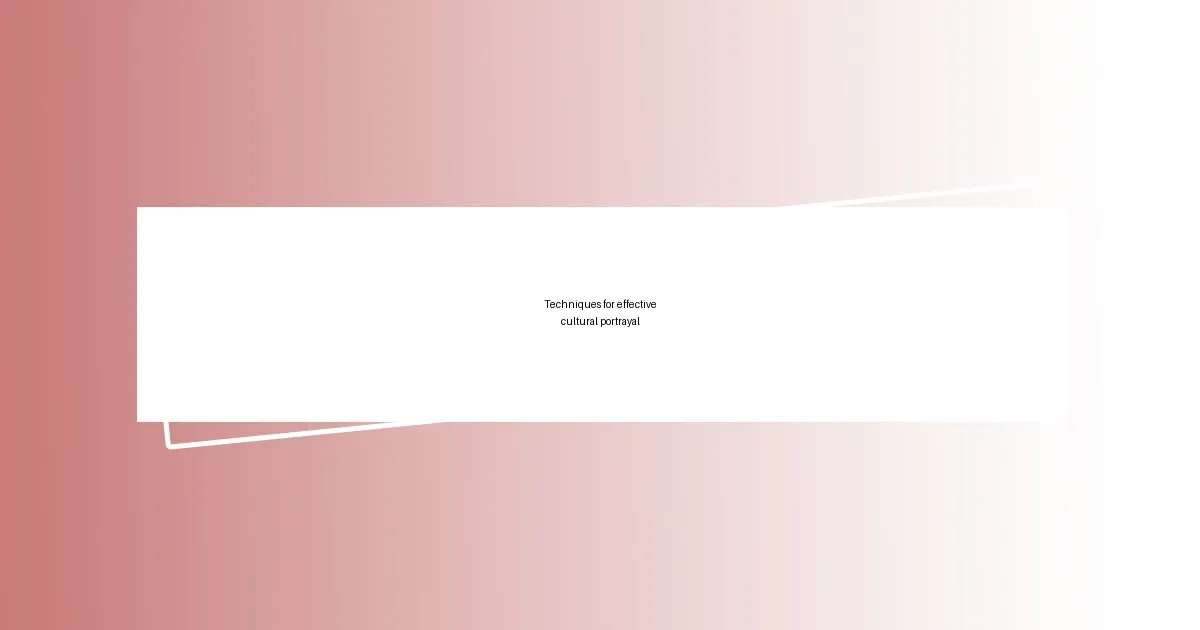
Techniques for effective cultural portrayal
When I think about techniques for effective cultural portrayal, one approach that stands out is storytelling through symbolism. For instance, during a community art workshop, I used a simple feather to represent freedom and the strength of my heritage. This small detail sparked conversations among participants, revealing how symbols can resonate differently based on individual experiences and backgrounds. Have you ever noticed how a single image can evoke a lifetime of memories? It’s because people connect personally with symbols, making them powerful catalysts for cultural expression.
Another technique I’ve honed is the use of colors to evoke specific emotions tied to cultural significance. I remember a recent piece where I employed a rich palette of reds and golds reminiscent of vibrant festivals from my childhood. Bright colors often symbolize joy and celebration, while cooler tones can convey calmness and reflection. This interplay of colors helps convey the underlying cultural narratives that inform my art. It’s fascinating to see how viewers react differently—what feelings do you associate with certain colors?
Lastly, the technique of collaboration cannot be overlooked. Collaborating with artists from diverse backgrounds has enriched my understanding of cultural expression. I once worked on a project with a fellow artist who incorporated her Latin roots into our mural design. The blending of styles created a dialogue between our cultures, enhancing the depth of our message. Engaging in collaborative art not only broadens the perspective but also fosters a sense of unity within diversity, showcasing how our individual stories weave together into a more significant cultural narrative.
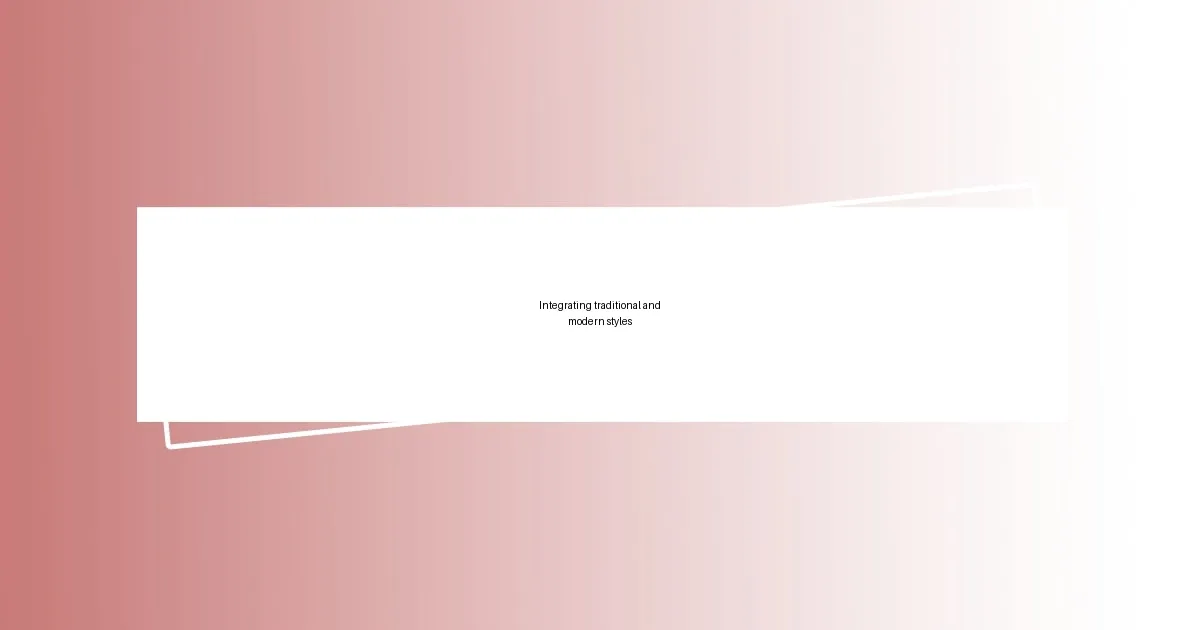
Integrating traditional and modern styles
When I create, I find myself drawn to the interplay between traditional forms and modern techniques. I once participated in an exhibition where I used ancient textile patterns, but melded them with a contemporary graphic design layout. The initial blending felt like a dance—each element complementing the other, harmonizing the rich history of my culture with the sleek lines of modern aesthetics. Isn’t it intriguing how art can bridge such vast temporal gaps, making the past accessible to today’s audience?
In another project, I explored ceramics, fusing traditional glazing methods with modern shapes. The result was a series of bowls representing both my ancestral origins and my current life. As I held them, I felt a palpable connection across generations. This practice of integrating styles is like a conversation across time; I often wonder how our thoughts and expressions can evolve yet remain rooted in what came before.
I also love how integrating traditional and modern styles expresses a narrative of resilience. For example, during a digital art exhibit, I projected images of indigenous symbols intertwined with urban landscapes. It created a striking visual dialogue that made the past feel alive within a contemporary context. Can you feel the energy when you see tradition standing shoulder to shoulder with modernity? This fusion not only highlights the strength of culture but also shows how it can adapt and thrive, communicating the essence of our identity amid changing times.
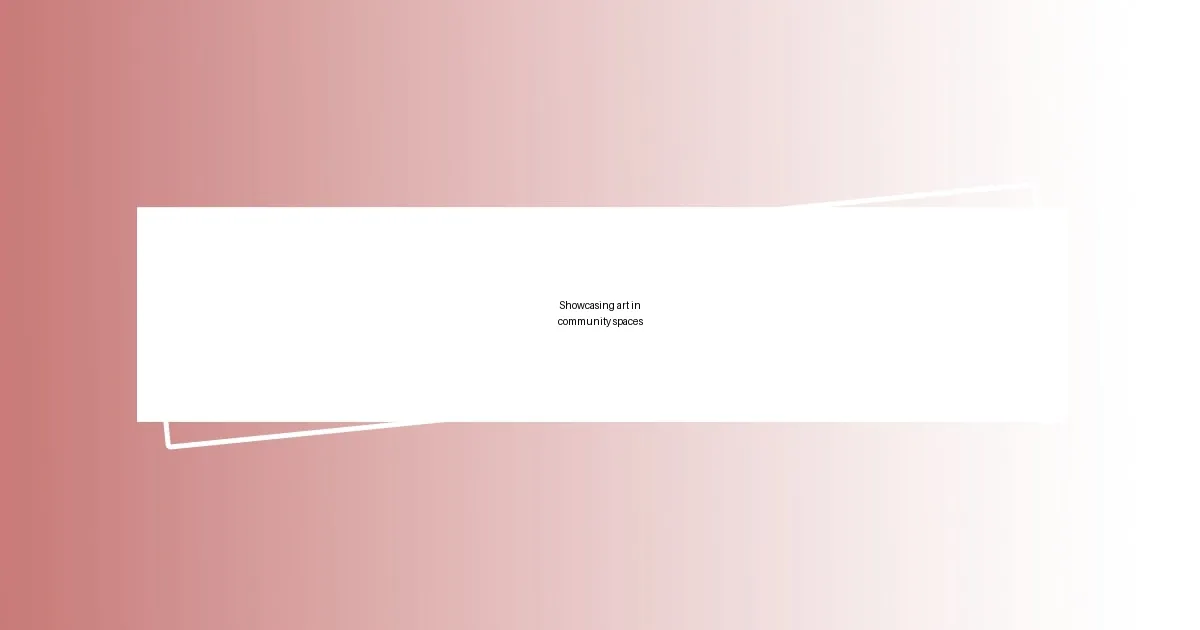
Showcasing art in community spaces
Showcasing art in community spaces allows for a vibrant expression of culture that resonates deeply with local identities. I recently organized a pop-up gallery in a local park, featuring works by diverse artists from our neighborhood. It was incredible to see how their unique stories unfolded through their pieces—each artwork acted as a visual narrative, drawing in visitors from all walks of life. Have you ever felt the excitement in the air during a local art show, where the community comes together to celebrate creativity?
What struck me most was the way these community spaces transformed into hubs of connection. As attendees gathered around the artwork, I witnessed spontaneous conversations erupt—people sharing their experiences and emotions sparked by the art. I remember one mother pointing to a vibrant mural and explaining to her child how it reminded her of their family’s cultural festivals. This interplay between artist and viewer encapsulates the heart of community art, fostering understanding and belonging. Isn’t it amazing how art can bridge generational gaps and ignite cherished memories?
Finally, there’s something profoundly fulfilling about seeing the artwork integrated into everyday community life. I recall a project where we adorned a local library with student-created pieces representing various cultures. The moment I saw children studying beside these beautiful works, animated discussions surrounding them, I knew we had created a dynamic space where culture is part of the learning experience. It’s a reminder that art isn’t just something to admire; it’s an integral part of our daily narratives. Isn’t this synergy what every community needs, a constant reminder of its rich tapestry of stories?
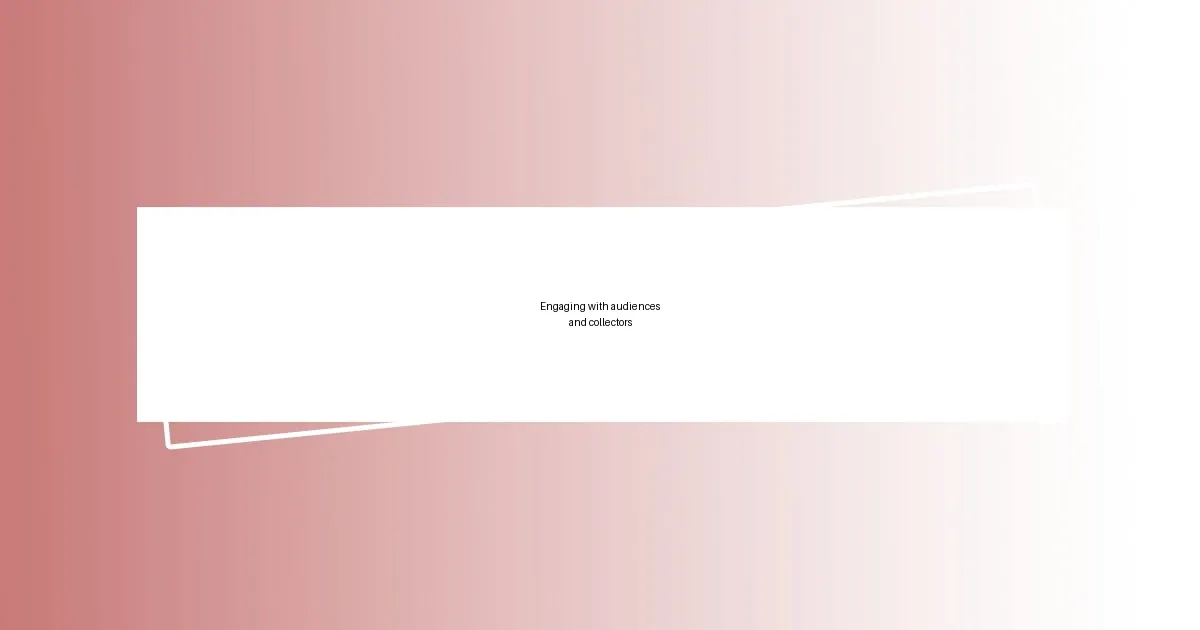
Engaging with audiences and collectors
Engaging with audiences and collectors has always felt like a two-way street to me. I remember my first experience at an art fair, nervously presenting my work, only to find a collector captivated by a piece that reflected my cultural heritage. As he stood in front of it, I could see a flicker of recognition in his eyes. It was a moment that reinforced my belief: art isn’t just for the creator; it can transcend personal boundaries and spark connections between unfamiliar souls. Have you ever witnessed such transformations within the art world?
I strive to create engaging narratives around my work that resonate with collectors and audiences alike. One memorable evening, while discussing the cultural significance behind a series of paintings, I noticed how intensely the viewers listened. Their engagement brought out a wave of shared emotions among them—a realization that the art told their stories too. It made me wonder: can art be a reflection of collective memory, uniting diverse experiences into a single conversation?
In my interactions, I focus on fostering relationships rather than just making sales. After a gallery show, a young aspiring artist approached me, eager to learn more about my process. We talked about our cultural backgrounds and artistic journeys late into the evening. I realized then how vital these connections are—not just for mentorship, but for creating a supportive community around art. Isn’t that what truly enriches our creative endeavors, the bonds we form and the stories we share?



